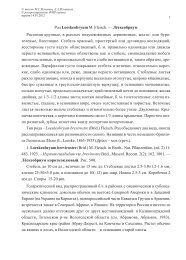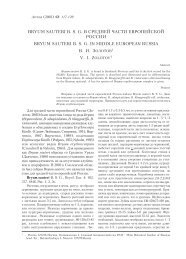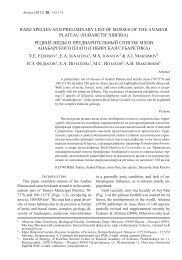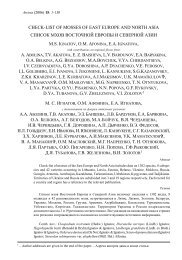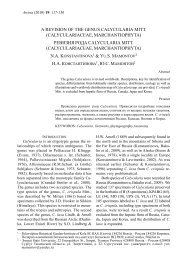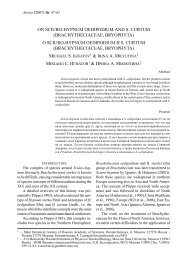THE GENUS BRYUM (BRYACEAE, MUSCI) IN MIDDLE ... - Arctoa
THE GENUS BRYUM (BRYACEAE, MUSCI) IN MIDDLE ... - Arctoa
THE GENUS BRYUM (BRYACEAE, MUSCI) IN MIDDLE ... - Arctoa
Create successful ePaper yourself
Turn your PDF publications into a flip-book with our unique Google optimized e-Paper software.
182<br />
vine-red; not tomentose; rhizoids brown or<br />
brownish, finely papillose. Stem deep red, 1 cm<br />
long, rarely higher, evenly foliate along most of<br />
stem, few leaves comosely crowded above, subterminal<br />
shoots 1-3(-4), to 1.0-1.5 cm long,<br />
+evenly foliate and comose above. Leaves of<br />
subterminal shoots and leaves from sterile<br />
shoots 2.0-2.4 mm long and 0.7-0.9 mm wide.<br />
Upper leaves erect to spreading when wet, loosely<br />
appressed and moderately curved when dry,<br />
delicate, to 3.0-3.1 mm long, 0.8-1.0 mm wide,<br />
obovate to oblong-obovate, widest at 1/3-1/2<br />
of leaf length, acuminate to longly acuminate,<br />
rather longly decurrent, without red color at<br />
base but sometimes pinkish throughout; margin<br />
recurved to reflexed from base to acumen<br />
or to mid-leaf, entire or weakly serrulate above;<br />
border inflated, 2-3-rowed, 1-2-stratose, yellow<br />
to brownish, composed by long thick-walled<br />
cells; costa always very stout, fuscous to reddish,<br />
later brown, ending in leaf tip or excurrent<br />
in very short awn. Laminal cells thin-walled,<br />
not porose, in upper leaf rhomboid-hexagonal,<br />
40-60 x 16-24 μm; in mid-leaf rhombic to rhombic-hexagonal,<br />
(40-)60(-80) x 16-24 μm, at base<br />
rectangular and rhomboid-hexagonal, 60-80 x<br />
(20-)28-32(-36) μm.<br />
Perichaetial leaves lanceolate, acute, margin<br />
plane, costa percurrent to shortly excurrent. Seta<br />
(2.0-)2.5-3.5(-5.0) cm, fuscous to reddish-brown,<br />
not twisted when dry, arcuate below capsule.<br />
Capsule horizontal, inclined to pendulous, pale,<br />
brownish to yellowish-brownish, 4.0-5.0 mm long,<br />
1.5-2.0 thick, oblong-pyriform, with broad mouth,<br />
not or slightly contracted below mouth when<br />
dry; with narrow +curved neck to twice as long<br />
as urn. Operculum large, conic or conic-convex,<br />
with small acute apiculus, orangish, slightly glossy.<br />
Annulus 4-5-rowed. Peristome inserted at mouth,<br />
ca. 560 μm high. Exostome teeth curved in dry<br />
condition with upper teeth inserted in between<br />
endostome segments; at base ca. 100 μm wide,<br />
gradually tapered, below light-yellow, in uppermost<br />
part hyaline; narrowly bordered, median<br />
line zig-zag-shaped; fundus yellow to orange, 60-<br />
70 μm high, broadened; ventral trabeculae 26-<br />
27(-30), longitudinal sepatae absent. Endostome<br />
free, yellowish to yellow; basal membrane ca. 1/<br />
2 of endostome height; segments narrow, halfsegment<br />
at base 40-50 μm wide, broadly perforate<br />
below (sometimes perforations fusing in large<br />
V. I. ZOLOTOV<br />
irregular gaps) and narrowly split above; cilia<br />
2-3, 1/2-7/8 of segments length, densely papillose,<br />
appendiculate to nodose. Spores 16-20 μm,<br />
yellow-green.<br />
Axillary brood filaments sometimes present,<br />
nearly translucent to pale-fuscous or pale-pinkish,<br />
finely papillose to nearly smooth.<br />
Differentiation: Bryum pallens usually can<br />
be recognized in the field by its vine-red to<br />
dirty-pinkish color, better expressed in sunny<br />
places. In shady places, this species is olive-green;<br />
in this case, the following combination of character<br />
states can serve for its identification: (1)<br />
dioicous sexual condition; (2) a long curved<br />
capsule (similar to that of B. uliginosum, but<br />
with a broader mouth); and (3) free endostome<br />
and little reduced, nodose to shortly<br />
appendiculate cilia.<br />
Habitat: Common on wet and moist sandy,<br />
clayish, muddy, or peaty soil, bare or with scattered<br />
herbs, forming pure stands or often intermixed<br />
with other species; on lake and pond shores,<br />
swampy places, along streams and creeks, on damp<br />
places in wet meadows, pits, along cuvettes and<br />
trails. Usually on non-calcareous soils.<br />
Selected specimens examined (60): Arkhangelsk Prov.,<br />
Ignatov 30.VII.1988, MHA; Bashkortostan, Ignatova #2/<br />
50, MHA; Kaluga Prov., Boczkin 5.VIII.1989, MHA;<br />
Kostroma Prov., Ignatov 18.IX.1990, MHA; Kursk Prov.,<br />
Ignatov 13.VIII.1996, MHA; Moscow Prov., Ignatov<br />
22.VIII.1985, MHA; Nizhnij Novgorod Prov., Shvezov<br />
17.VII.1913, LE; Pskov Prov., Zolotov 18.VIII.1998, MHA;<br />
Ryazan Prov., Ignatov 1.X.1999, MHA; Tatarstan, Krylov<br />
13.VI.1983, LE; Tver Prov., Gordeeva 14.VIII.1984, MHA;<br />
Vladimir Prov., Nazarov 19.IV.1913, LE; Voronezh Prov.,<br />
Popova 638, 12.VI.1981, VOR; Yaroslavl Prov., Kostyleva<br />
25.V.1984, MHA.<br />
Bryum cyclophyllum (Schwaegr.) B.S.G.,<br />
Bryol. Eur. 4: 133. 1839. – Mnium cyclophyllum<br />
Schwaegr., Sp. Musc. Frond., Suppl. 2 2(2):<br />
160. pl. 194. 1827. Fig. 76-77<br />
Dioicous; male and female plants in the same<br />
tuft, but often whole tuft having only male<br />
plants; perigonia capitate, with numerous purplish<br />
antheridia and yellow paraphyses; paraphyses<br />
slightly longer than antheridia; perigonial<br />
brackts orangish, to 1 mm long, ovate to<br />
broadly ovate, concave, acuminate, plane margin,<br />
with short weak costa; perigonia surrounded<br />
by 5-7 broadly oblong leaves, crowded terminally<br />
and forming cup-like structure.<br />
Plants in very loose, soft tufts 1.5-2.5(-8)<br />
cm long or scattered among other mosses; high



